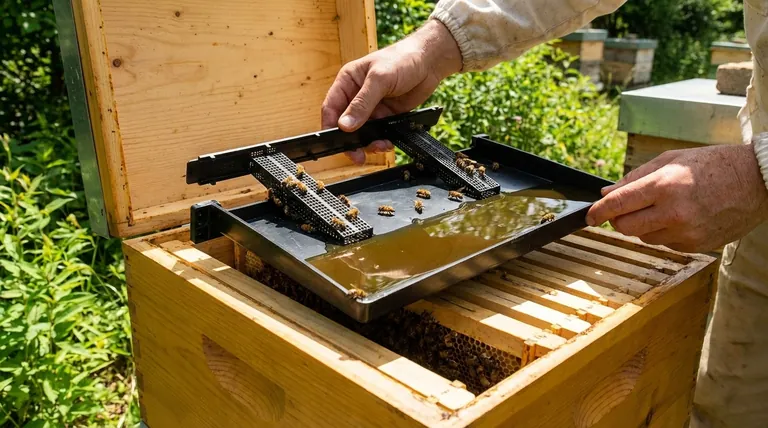In short, a standard frame feeder's capacity depends on the size of your hive. For a typical 10-frame hive, a frame feeder will hold approximately 4 gallons of syrup. If you are using an 8-frame hive, the corresponding feeder will hold slightly more than 3 gallons.
The key consideration is not just the volume a frame feeder holds, but how its large, in-hive capacity affects your hive management, from reducing refills to the risk of bees drowning.

Understanding Frame Feeder Capacity
A frame feeder, also known as a division board feeder, is designed to fit inside the hive body, taking the place of one or more frames. This design directly influences its volume and function.
Standard 10-Frame Feeders
A frame feeder built for a standard 10-frame Langstroth hive is the largest common size. Its typical capacity is around 4 gallons.
Standard 8-Frame Feeders
For the slightly smaller 8-frame Langstroth hive, the feeder is narrower. It generally holds a bit more than 3 gallons of liquid feed.
Why This Large Capacity Matters
The significant volume is a primary advantage. It allows a beekeeper to provide a large amount of syrup in a single visit, minimizing disturbance to the colony. This is especially useful for rapid feeding in the fall to build up winter stores or during a nectar dearth.
The Core Trade-offs of In-Hive Feeding
While the large capacity is a benefit, using a frame feeder involves a distinct set of pros and cons that you must weigh.
Pro: Reduced Robbing
Because the feeder is located entirely inside the hive, it dramatically reduces the risk of robbing. There is no external entrance or spilled syrup that can attract bees from other colonies, which is a common issue with entrance feeders.
Pro: Fewer Disturbances
A multi-gallon capacity means you don't have to open the hive as frequently to refill the feed. This reduces stress on the colony and saves you time and labor.
Con: Risk of Drowning
This is the most significant drawback of frame feeders. Without proper precautions, a large number of bees can fall into the syrup and drown. Many modern feeders have built-in ladders or floats, but it remains a critical factor to manage.
Con: Occupies Brood Nest Space
The feeder takes the place of frames that could otherwise be used by the queen for laying eggs or by the workers for storing honey and pollen. This can temporarily limit the expansion of the brood nest.
Making the Right Choice for Your Goal
Selecting a feeder depends entirely on your specific objective for the colony.
- If your primary focus is rapid weight gain for winter: The large capacity of a frame feeder is ideal for quickly delivering gallons of heavy syrup.
- If your primary focus is stimulating a small colony or nuc: A smaller feeder, like an entrance or top jar feeder, might be more appropriate to avoid overwhelming the bees and prevent drowning.
- If your primary focus is minimizing hive intrusion: A frame feeder or a high-capacity top feeder allows for the fewest refills and disturbances.
Ultimately, understanding a frame feeder's capacity is the first step in deciding if its benefits align with your beekeeping goals.
Summary Table:
| Hive Type | Frame Feeder Capacity |
|---|---|
| Standard 10-Frame Langstroth Hive | ~4 Gallons |
| Standard 8-Frame Langstroth Hive | ~3+ Gallons |
Ready to equip your apiary with the right feeders for efficient, large-scale feeding?
At HONESTBEE, we supply commercial apiaries and beekeeping equipment distributors with high-quality, durable frame feeders and other essential beekeeping supplies. Our wholesale-focused operations ensure you get the reliable equipment you need to support healthy, productive colonies.
Contact our expert team today to discuss your needs and get a quote for your operation.
Visual Guide

Related Products
- 3.5L Plastic Beehive Frame Feeder Deep Frame Water Feeder for In Hive Use
- Professional In-Hive Frame Bee Feeder by HONESTBEE
- In-Hive Dual Compartment Frame Bee Feeder for Targeted Colony Nutrition
- Professional Hive Front Entrance Bee Feeder
- Boardman Entrance Bee Feeder Durable Galvanized Steel and Wood Construction for Beekeeping
People Also Ask
- What are the two most popular types of honey bee feeders? A Guide to Frame and Bucket Feeders
- How do I keep bees from drowning in my frame feeder? Essential Tips for a Safe Hive
- What are frame feeders, and what are their advantages? Essential for Cold Weather & Efficient Feeding
- What is a frame feeder? A High-Capacity, Secure In-Hive Feeding Solution
- What are the advantages of frame feeders? Ensure Safe, In-Hive Feeding for Your Colony



















